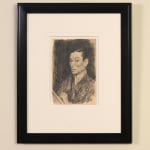


Chusei Inagaki (1897-1922)
Self Portrait
Ink on paper
framed : 19 7/8'' h x 16 1/2'' w
Further images
The stunning self-portrait shows the artist Chusei Inagaki’s abandoned talent. He was born in 1897 and died in 1922, living only 25 years. In his short life, he observed with...
The stunning self-portrait shows the artist Chusei Inagaki’s abandoned talent. He was born in 1897 and died in 1922, living only 25 years. In his short life, he observed with his own eyes, interpreted with his own mind, studied searching his own expression, and painted and drew in his own way. He was born too early and died too young. Inagaki left behind so many masterpieces, many of which now hang in museums. As was true for a visionary like Van Gogh, his talent was not appreciated during his time. His works received savage criticism, and were labeled as iconoclasts by old school academics and critics. He did not live long enough to defend himself, but now museums are competing to acquire his works. His paintings and drawings, like this one, possess realism imbued with a psychological disquietude, a rare expression for Japan in that era.
Standing in front of his self-portrait and looking the work eye to eye, one feels to be succumbed by its hypnotic gaze. Inagaki bares his face, inviting the observer into a mind with an iron will, constantly grappling with agony, the genius’s mind. The pen strokes of the self-portrait remind us of Van Gogh’s pen drawing, fueled by a similar agony. Just imagine seeing the self-portraits of the two geniuses together. Inagaki left behind few self-portraits, and most of them are in the National Museum of Modern Art in Kyoto. Even compared to those, this one is far excellent.
Standing in front of his self-portrait and looking the work eye to eye, one feels to be succumbed by its hypnotic gaze. Inagaki bares his face, inviting the observer into a mind with an iron will, constantly grappling with agony, the genius’s mind. The pen strokes of the self-portrait remind us of Van Gogh’s pen drawing, fueled by a similar agony. Just imagine seeing the self-portraits of the two geniuses together. Inagaki left behind few self-portraits, and most of them are in the National Museum of Modern Art in Kyoto. Even compared to those, this one is far excellent.
Signup for our Newsletter
You will receive two emails a month from us. One introduces artworks and design works from Kyoto's hidden sources and the other is stories from Misako, sharing insights into Japanese culture.
* denotes required fields
为了回应您的查询,我们将根据我们的隐私政策处理您提供的个人数据。


